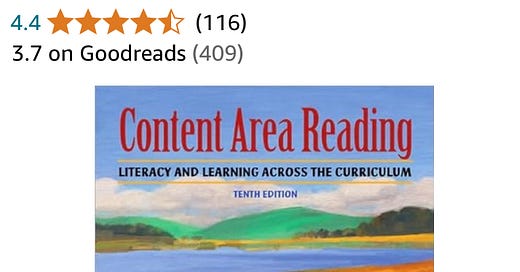As a professor in three different reading specialist programs and teacher preparation programs, I taught a range of courses from elementary methods for teaching reading to theoretical models of composition and comprehension to literacy leadership in schools. Secondary reading methods, however, was on my schedule almost every semester for close to twenty years.
I’ve written before about the Vacca and Vacca text, one of a handful of textbooks competing for the eyes of future high school teachers. Amazon offers the 10th edition published in 2010 still available brand new.
In this post, I’m not trying to sell a book. I’m not trying to persuade you that this way is the right way or the only way to think. I’m using this book as a metaphor for keeping longstanding and hard won insights into reading in the minds of teachers. This book has sailed through changing ocean tides and based on my experiences helped hundreds of teachers.
*
Individual recipes or teaching scripts are a dime a dozen, especially now in the age of the Science of Reading where politicians masquerade as educators and push recipes. Recipes are useless without wisdom derived from sustained subject matter study and experience which has been reflectively analyzed. Chefs understand recipes well enough to ignore them in the moment.
My first encounter with V&V in 1986 came about when I was hired part-time to teach a section in a boutique single subject credential program. By “boutique” I mean small. Big credential programs can graduate hundreds of teachers per year. Small? Under a hundred. I used it every semester for the next two decades. Why? It worked for students. Every new and updated edition.
*
I love the swirl of meanings flowing from the cover of the book. The eye is drawn to a small plate and a green apple sitting on a table. Apple means teacher, right, and in this case, the apple is green, a slice waiting to be eaten. A green teacher eating a green apple—methinks I detect some visual poetry dancing on the cover. Read this book and you shall morph into a green apple with a teaching credential.
On the table is a laptop. Of course, laptops were not around much in the 1980s. Being on the scene in 2010 this laptop is a reminder of the turbulence in literacy instruction which still rattles the field. But the table is filled mostly with hardback books, a feast of knowledge, apples from the tree of knowledge seen as books.
The eye is drawn into the far distance where fluffy clouds float in a blue sky above a blue lake near rolling hills. Let’s talk about chemistry here. Situating the tableau of the sliced apple, the laptop, the books, and the teacher who has to be in this picture though unseen, the authors must have enjoyed the opportunity to compress their book into a visual metaphor.
Notice the title: Content Area Reading. Although in 2010 this term was on its way out in favor of the more expansive term “literacy,” our authors were not ready to let go, and I understand perfectly. For them, I think, content means content—the “what” of reading.
For others, content area means “academic disciplinary subject matter.” I still prefer “content area reading” because it means paying attention to information in any discipline. Chapters become cross-curricular tools with similar features, books becomes toolboxes, and a reader becomes a student working with tools and a toolbox to build knowledge.
In the business of teacher prep we called this sort of teaching “functional reading instruction” to distinguish it from “direct instruction.” In a disciplinary classroom with a primary focus on knowledge building, providing a toolkit and then not teaching students how to use the tools makes little sense.
V&V delivers on teaching teachers to teach tools for learning with text. “With” in this case is as carefully chosen as the slice of apple, which was taken from the whole fruit with precision. The significance of a preposition…
Amazon gives us the following language for a preview of the textbook:
“With the underlying belief that students learn with texts, not necessarily from them, this respected text is designed to be an active learning tool, complete with real-world examples and research-based practices. Reading, writing, speaking, and listening processes to learn subject matter across the curriculum. Content Area Reading.”
It’s far more important that educational administrators who haven’t studied content area reading instruction understand that this pedagogical knowledge exists. Every secondary teacher in the country has taken this course.
It is a highly specialized area that ought to be in the wheelhouse of every high school classroom teacher who gives reading assignments, and like any good chef, teachers need to understand these recipes well enough to make up their own using professional knowledge and judgement.



